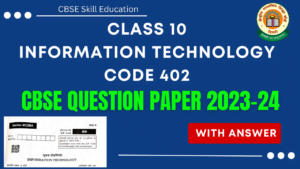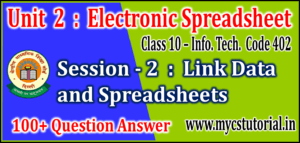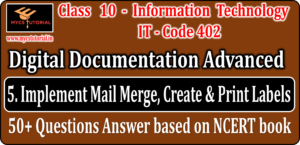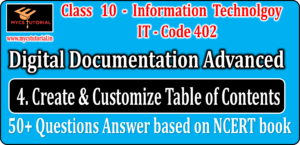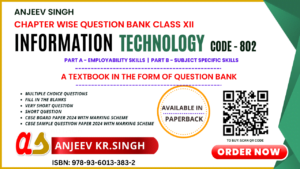Class 10 Unit 1 – Communication Skills – II Notes with Worksheet
Hello Dear Readers!
In this post, I seek to furnish you with study material based on the NCERT Book on Unit 1 Communication Skills -II. It is widely known that Employability Skills are a requirement for every Skill Education course. I sincerely hope that this study material will assist you in your exam preparation and help you secure good grades in the examination.
Let us comprehend what topics you should study for Unit 1 Communication Skills II.
Syllabus as per CBSE:

Study Material/Notes
Communication:
The word communication is derived from latin word Communis or Communicare, which means to
make common, i.e. to share. Communication means the exchange of ideas, thoughts, opinions, information, messages, feelings, emotions, etc.
Communication Process:-
The process of sending and receiving messages through verbal or nonverbal means including speech or oral communication, writing or written communication, signs, signals, and behaviour is called Communication Process.
Forms of communication:–
(i). Verbal Forms – communicating orally.
(ii) Non-verbal form (communicating using body language, gestures, or tone and pitch)
(iii) Written form – communicating via handwritten or printed information.
(iv) Visual form – communicating via pictures, logos, posters, maps or charts, etc.
Verbal communication:- The style of communication in which you interact with others through words i.e. orally called Verbal Communication, It is an interactive form of communication.
Pros / Advantages of verbal communication
Verbal communication has the following pros/advantages –
- It is straightforward to express the feelings.
- It is an interactive form of communication.
- It is a speedy form of communication.
- Easy to give instant feedback.
- The preferred form for maintaining relationships.
Cons / Disadvantages of Verbal Communication:
Verbal communication has the following cons/disadvantages-
- Not easy to communicate to people of different region or language.
- It require proximity.
- No permanent records.
- Not possible to represent legally or officially.
- It is not a complete form of communication.
- There are emotional barriers.
Non – Verbal communication
The process of wordless communication i.e. sending and receiving wordless messages between people using body language, gestures, and voice-tones, etc., is called Non-verbal communication.
Pros of Non-Verbal communication:-
Non-Verbal communication has the following pros/advantages-
- Very easy to demonstrate.
- Very useful for conveying a message where verbal is unable to reach.
- No language barriers.
- Conveys the messages very fast.
Cons/disadvantages of non-verbal communication: Non-Verbal communication has the following cons/disadvantages-
- Non-verbal communication is not suitable for lengthy messages.
- It is an incomplete form of communication.
- Chances of misinterpretation by the receiver.
- Regional and cultural differences are barriers for non-verbal communication.
Visual communication :
Communicating by using non-verbal mediums such as posters, logos, visual aids, sign-boards, headings, etc. called Visual Communication.
Class 10 – Communication Skills Notes with worksheet
Pros / Advantages of Visual Communication:
Visual communication has the following pros/advantages –
- It reinforces other forms of communication.
- It can explain things in a way which are not possible through words.
- It clears the barrier of qualification or language.
Cons / Disadvantages of Visual Communication:
Visual communication has the following cons / disadvantages –
- Expansive medium of communication.
- Require specialised storing i.e. specific place and specific form of storage.
- It is a time consuming i.e. all forms of visual aids consume time for their preparation.
Written Communication : Conveying messages or information through written means is known as written communication. Eg. Letter, Mail, etc.
Pros / Advantages of Written Communication :
Written communication has the following pros / advantages –
- It can be recorded and stored permanently.
- It has a legal standing than other forms of communication.
- It facilitates re-use.
- It can be produced in bulk or duplicated multiple times.
- It is suitable for lengthy message and information.
- It conveys sincerity.
- All its copies are identical.
Cons / disadvantages of Written Communication :
Written communication has the following cons / disadvantages –
- It is costly.
- It is time consuming i.e. not an instant from of communication.
- It has a barrier of qualification / languages.
- It require a specific form of storage, so it is costly.
Examples of all forms of communication : –
Examples of different types of communication are –
- Verbal / Oral Communication – Meeting, Teleconference, Informal Talk, Video Conference, Oral presentation, Discussions, Telephonic talk, Public speaking, Lecture.
- Non-verbal Communication – Facial expressions, Tone of voice, Body Language, Hand movement, Gestures, Proximity, Warmth in appearance, Enthusiasm, Mood.
- Visual Communication – Logos, Signboards, Signs, Signals, Charts, Graphs, Images, Pictures, Illustrate, Cartoons animations..
- Written Communication – Letter, Email, Fax, Magazine, Article, Book, Document, Reports, Notices, Newsletter, Business card, Media release, Legal documents, Manuals.
Body language: – Body language is an aspect of non – verbal communication where physical behaviour is used (as opposed to or in addition to words) to convey information. Body language includes:
- facial expressions posture
- gestures
- touch
- the use of space
- eye movement
It’s also known as “kinesics”/ kinaesthetics.
Do’s of body language: –
Do’s of body language –
- Make Eye Contact
- Have a firm handshake
- Check your facial expression.
- Be natural with your gestures.
- Maintain a receptive posture.
- Refrain from sending mismatched messages
- Watch for actions that can be taken for defensiveness.
- Don’t appear disengaged.
Don’ts of body language: –
Don’ts of body language –
- Rubbing your hands together during an important meet up
- Leaning back while meeting with a friend or close colleague.
- Crossing your arms during an interesting conversation.
- Not making eye contact.
- Making too much eye contact.
- Fidgeting.
- Touching your face too often.
Learning objectives of effective communication : – Learning objective of effective communications are
- Sending, receiving and understanding the message or information
- Development of Interpersonal Skills
- To express effectively with maximum efficiency
Information Technology
Class 10 – Communication Skills 50+ most important quiz
Communication Cycle
Communication cycle is the process by which a message is sent by one individual, and it passes through a chain of recipients.
Elements of Communication
Elements of Communication are :-
(a) Sender (Communicator)
(b) Receiver
(c) Message
(d) Communication Channel
(e) Response / feedback.
Feedback
Feedback ensures the successful delivery of message. Feedback completes a two-way communication.
Important of Feedback in communication?
Feedback is important as it ensures the success and effectiveness of communication. Without feedback, the sender cannot find if the message intended has been successfully delivered with the same intent.
Characteristics of Feedback
Feedback has following characteristics :
a) Intention
b) Specific
c) Fair and Non-judgmental
d) Timeliness
e) Usefulness
f) Clarity
Types of Feedback?
Feedback can be in various forms and types. These are
a) Formal & Informal Feedback
b) Descriptive and Non-descriptive Feedback
c) Specific and Non-specific Feedback.
Formal & Informal Feedback
Formal Feedback – In formal feedback, receiver gives the feedback in the preset format or structure. It has many predefined points and has a specific blueprint. It takes times to construct.
Informal Feedback – is an instant feedback and does not stick to a specific structure. Such as instant comments given by listener or audience. Eg. Good, Sorry, etc.
Descriptive & Non-Descriptive Feedback
Non-Descriptive Feedback – The feedback which conveys meaningful specific response but does note give detailed descriptions, called Non-Descriptive Feedback. Eg.
“In your homework, index needs to rewrite”
Descriptive Feedback – A feedback which provides meaningful information in a detailed, expressive manner and also contained some suggestions etc, called Descriptive Feedback. Eg.
“In your homework, you have not written the index properly. You need to mention the data, chapter number and chapter name”
Specific & Non-Specific Feedback
Specific Feedback – The specific feedback talks about a thing or a point particularly without taking about a general overview. Example-
“I like your story. It is good”
Non-Specific Feedback – In Non-Specific feedback, they talks about everything while giving a general overview. It does not pinpoint a specific thing / feature. Eg.
“I like the way you described your super hero character. It makes me feel like I know him very well. It is good. I love your story.”
Effective Communication
Effective communication is a two-way communication process where both parties (i.e. sender and receiver) have right and convenience to express their messages, opinions, facts, information etc.
Principles of Effective Communication
Effective communication has some principles which need to be follows. These are –
(a) Clarity – should be clear and easy understandable.
(b) Attention – receiver must be attentive.
(c) Consistency – consistent with the planned objective.
(d) Adequacy – information must be complete and adequate.
(e) Timeliness – message must be given at proper time, otherwise communication will lose its importance and effectiveness.
(f) Feedback – receiver must give the feedback to sender.
(g) Economy – communication process must be cost effective i.e. less costly.
Information Technology
Class 10 – Communication Skills 50+ most important question answer
The 7C’s of Effective Communication
7 C’s of Effective communication – are the set of rules which must be followed by sender while creating the messages. These rules are –
(i) Control – Control over yourself, body language, tone, pace, etc..
(ii) Conversational– must be two-way communication i.e. try to converse to involves the other person.
(iii) Confident – Sender must be confident.
(iv) Competent– deliver of message in a way which can be understand by receiver i.e. sender must be competent to deliver the same message differently.
(v) Calm – sender must be calm and relaxed.
(vi) Clear – Be clear in message, i.e. easy to understand by receiver.
(vii) Concise – Always be specific, don’t waste valuable time. Always deliver in a short and concise way.
Barriers in Effective Communication?
Barriers in communication are –
(i) Lingual Factor / Language Barriers
(ii) Environmental Fact
(iii) Past Experiences / Past habbits
(iv) Cultural Influence
(v) Prejudice / Preconceptions
(vi) Feelings / Emotions / Mood
(vii) Personal Factors / Lack of confidence
What is Sentence?
A sentence is a group of words giving a complete thought. A sentence must contain a subject and a verb. There are three types of sentences – (a) Simple Sentence (b) Compound Sentences and (c) Complex Sentences.
Simple Sentence
A simple sentence is one independent clause that has a subject and a verb and expresses a complete thought.
• Must have a subject and a verb.
• Must express a complete thought.
• Must only have one clause.
Examples
• I am out of paper for the printer.
• Will you help me with the math homework?
Compound Sentence
A compound sentence allows us to share a lot of information by combining two or more related thoughts into one sentence.
Example :- I drove to the office, and then I walked to the cabin.
Complex Sentence
Answer: A complex sentence is a sentence that combines one independent clause with at least one dependent clause.
Example:-
•Although Rohan had some doubts, he found the courses very useful.
•Computers have come a long way since they first came on the market.
What is Phrases?
Phrases are a group of words that work together to communicate an element of speech.
Types of phrases are –
i) Prepositional Phrases ii) Participial Phrase iii) Appositive Phrase. iv) Gerund Phrase v) Infinitive Phrase
Parts of Sentence
Answer: Every sentence can be broken into two parts-
a) Complete Subject – The complete subject consists of simple subject ( The noun or the pronoun is the subject is about) and its modifiers
b) Complete Predicate – The complete predicate is made of up of verb and its modifiers.
The old man built a road.
the subject is – “the old man”
the predicate is – “built a road”
What is Object?
The object is a part of the predicate. Object tell about the things being acted upon by the verb.
The old man built a road.
the subject is – “the old man”
the predicate is – “built a road”
- the object is – ‘ a road’
- the verb is – ‘ built’
What is Parts of Speech?
A category to which a word is assigned in accordance with its syntactic functions.
In English the main parts of speech are noun, pronoun, adjective, verb, adverb, preposition, conjunction, and interjection.
Information Technology
Types of Parts of Speech with example
There are eight parts of speech in English. These are
(i) Noun – A word for a person, place of things. e.g. – Rama, Chennai, Box, Info Tech, democracy, gravity, etc.
(ii) Pronoun – A word that stands in for a noun i.e. to use in place of noun. e.g. he, she, I, we, they, him, her, me, us, them.
(iii) Adjective -A word that describes the noun or pronoun. e.g. green – ‘green leaf’, young in ‘young girl’
(iv) Verb – A doing word. e.g. cried, jump, read, like, etc.
(v) Adverb – A word that describes an adjective, adverb or verb. e.g. quickly, slowly, carefully, etc.
vi) Preposition – A word that shows the position in time or space i.e. shows relationships. e.g. on, over, for, besides, etc.
vii) Conjunction – A word that connects two sentences together i.e. joining words. Eg. and, but, or, because.
viii) Interjection – A word of surprise. Eg. hey, well, now, so, Wow!, Oh my!
ix) Article – A word that introduces a noun. e.g. a, an, the
What is Quantifiers?
The words that describe the quantity or amount of a noun are called quantifiers. e.g. much, many, little, few, bit, several, etc.
Countable Nouns
Countable nouns are those which can be counted. Countable noun can be used in both singular and plural forms e.g, books, apples, pens, phones, rooms, glasses, etc.
Uncountable Nouns
Uncountable nouns are those which cannot be counted. Uncountable noun can be used in singular forms e.g, books, apples, pens, phones, rooms, glasses, etc.
Quantifiers for Countable & Uncountable Nouns
Quantifiers are used when we want to give information about number or quantity of a noun.
| Countable Nouns – Quantifiers | Uncountable Nouns – Quantifiers |
| much, a little, little, very little, a bit, a great deal of, a large amount of, a large quantity of , a bit of | many, a few, few, very few, a number, several, a large number of, a great number of, a majority of, couple of |
Quantifiers that can be used with both Countable & Uncountable Nouns
Quantifiers are used when we want to give information about number or quantity of a noun.
| Common Quantifiers – Countable & Uncountable Nouns |
| all, enough, more, most, less, least, no, none, not any, some, any, a lot of, lots of, plenty of, heaps of, tons of, loads of |
What is Article Writing?
Article writing is the process of creating a non-fiction text about current or recent news, items of general interest or specific topics.
Format of Article writing

What is a Paragraph?
A paragraph is a series of sentences that are organized and coherent, and are all related to a single topic.
A paragraph is a group of sentences that describes one idea.
Parts of a Paragraph
A paragraph is having different parts –
a. Topic sentences
b. Supporting details
c. Colourful vocabulary
d. Concluding sentences
Rules for writing a good paragraph are :-
A basic rule of writing a paragraph is –
A paragraph represent one idea., if you have to write about different idea, start a new paragraph.
To write a good paragraph, you need to follow these rules –
a) Write an Outline for the Paragraph – (i) topic and (ii) supporting information of the topic
b) Write the topic sentence – that describe the topic.
c) Write supporting sentences for each outline, with the help of example or facts.
d) Write the concluding sentence, i.e. sum up the idea of the paragraph.
e) Combine all the lines to get your final paragraph.
Information Technology / Informatics Practices / Computer Science
- Class 10 Information Technology Code 402 Question Paper 2024 Download Paper with Solution

- Class 12 Information Technology Code 802 Previous Year Paper with Solution Book Order Now
- CBSE Class 12 Information Technology Code 802 Chapter wise Question Bank with Answer Book Order Now

- Class 10 Information Technology 402 CBSE Previous Year Question Bank and SQP

- Class 10 Information Technology 402 – Video Tutorial
- Class 10 IT Code 402 Electronic Spreadsheet Advanced Session 2 – Link Data and Spreadsheets Question Answer

- Class 10 IT 402 Unit 1 – Digital Documentation Advanced Session 5: Implement Mail Merge and Printing Labels Question and Answer

- Class 10 IT 402 Practical Activity for Practical File

- Class 10 IT 402 Unit 1 – Digital Documentation Advanced Session 4: Create and Customize Table of Contents Question and Answer

I tried my best to put all topics of Class 10 – Unit 1: Communication Skills.

If you found or noticed any thing is given wrong, please give your suggestions. I am always welcomes your suggestions with my open heart.
Happy Learning !! Stay Home !! Stay Safe
Thanks

